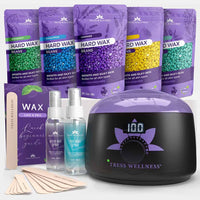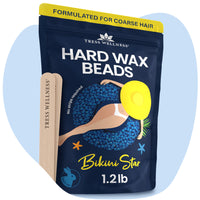Can I reuse hard wax for hair removal? The short answer is yes, but it’s not recommended due to hygiene and effectiveness concerns. Reusing hard wax can lead to bacterial contamination and decreased performance. In this article, we’ll cover the pros, cons, and tips for safely managing hard wax.
Key Takeaways
-
Hard wax beads are great for home waxing as they reduce pain and reduce ingrown hairs, but reusing them poses hygiene risks.
-
Reusing hard wax beads can save money and reduce waste, but it can also decrease effectiveness and increase the risk of skin irritation.
-
To safely reuse hard wax, strain and store it properly, and always check for signs of contamination before reusing.
Understanding Hard Wax Beads

Hard wax beads are a game-changer in the world of hair removal. Unlike soft wax, which requires strips to remove, hard wax adheres directly to the hair, not the skin. This makes it less painful and ideal for sensitive areas like the face and eyebrows. Hard wax beans are particularly effective in reducing ingrown hairs, as they pull hair out from the root without breaking it.
Waxing at home becomes more affordable with hard wax beads compared to expensive salon visits. The application process is straightforward: melt the beads, apply a thick layer to the desired area, wait for it to harden, and then pull it off. A thick layer of hard wax adheres better to hairs and is easier to remove than soft wax. Plus, you don’t need any paper or cloth strips, which streamlines the whole process.
Hard wax beads offer longer-lasting results than shaving. As a result, you enjoy smoother skin and less frequent hair removal sessions. Many people now prefer hard wax beads for their home waxing routines.
Is It Safe to Reuse Hard Wax Beads?
Reusing hard wax beads raises significant safety concerns. The main risks involve contamination, decreased effectiveness, and skin irritation. While hard wax can be reheated multiple times, the melting temperature is not high enough to kill bacteria, posing a risk of infection. This means that any leftover wax that has touched skin or hair should ideally be discarded to prevent contamination.
Check for signs of contamination or changes in texture before reusing hard wax beads. If the wax appears discolored or has an unusual consistency, it’s best to err on the side of caution and not reuse it. Keep hard wax for individual use to avoid bacterial transfer between multiple people.
While some may argue that reusing hard wax beads can be cost-effective, the hygiene concerns often outweigh the benefits. While it’s essential to keep the wax clean and free of debris, the risk of bacterial growth still exists. Therefore, reusing hard wax beads is generally discouraged due to hygiene and effectiveness concerns.
Pros and Cons of Reusing Hard Wax Beads

There are both advantages and disadvantages to reusing hard wax beads. The main advantage is cost-effectiveness, reducing the frequency of purchasing new waxing supplies. This is particularly appealing for regular waxers looking to save money. Moreover, reusing wax reduces environmental waste, aligning with sustainable practices.
However, there are significant downsides to consider. However, the adhesive properties of hard wax degrade with each reuse, reducing its effectiveness. Consequently, you may not achieve the same level of hair removal as with fresh wax. Additionally, the risk of bacterial growth is a significant drawback, raising hygiene concerns. Reused wax can cause skin irritation and infections, making it less reliable for effective hair removal.
Ultimately, weigh these pros and cons when deciding whether to reuse hard wax beads. Although cost savings and environmental benefits are appealing, potential hygiene risks and decreased effectiveness are significant. It’s essential to assess whether reusing hard wax aligns with your personal needs and comfort level.
How to Safely Reuse Hard Wax Beads
If reusing hard wax beads, follow proper techniques to minimize risks. Key steps include straining the wax, storing it correctly, and reheating it safely. These steps help maintain the wax’s hygiene and effectiveness for future use.
Let’s break down these steps in detail to understand how to safely reuse hard wax beads.
Straining the Wax
Straining the wax is the first essential step in reusing hard wax beads. A fine mesh strainer or cheesecloth can remove some of the hair and other impurities from the melted wax. This process maintains the wax’s cleanliness but doesn’t eliminate bacteria.
Straining removes visible debris but doesn’t address all hygiene concerns. Bacteria and other microorganisms can still be present, so strict adherence to hygiene practices is essential to minimize the risk of skin irritation or infection.
Proper Storage
Storing leftover wax properly is crucial for maintaining its quality and hygiene. After straining, store the wax in an airtight container to protect it from air exposure and contamination. Store the container in a cool, dry place away from direct light and heat to preserve the wax’s consistency and effectiveness.
Whether you are storing used wax or unused molten wax, you can use a silicone bowl to store your leftover wax. The Tress Wellness silicone bowl slides right into your warmer before melting your waxing, and once you're done waxing, wait for the wax to cool and harden. Pop the wax out and store it for later. It's that simple! No mess, no stress.
An airtight container helps prevent bacterial growth, keeping the wax safe for personal use. Avoid sharing stored wax with others to reduce the risk of contamination and health issues.
Reheating Guidelines
Proper reheating is key to maintaining the wax’s effectiveness. Gradually heating the wax in a wax warmer helps maintain its consistency without overheating. A wax warmer provides precise temperature control, ensuring the wax melts evenly and stays at an optimal application temperature.
A wax warmer reduces the need for frequent reheating, saving time during the process. Consistent temperature control enhances the waxing experience, making it smoother and more effective.
When Not to Reuse Hard Wax Beads
Avoid reusing hard wax beads in some situations. Consider specific circumstances before deciding to reuse them. Avoid reusing wax if you have open wounds or skin infections, as it can introduce bacteria and worsen the condition. Individuals with skin conditions like eczema or psoriasis should also avoid reusing hard wax beads to prevent irritation or infection.
Discard wax contaminated with hair or dirt to avoid skin complications. If the wax changes in color or consistency, it may be degraded and should not be reused.
Prioritizing skin health and hygiene is crucial; sometimes, using fresh wax is better to avoid complications from reused wax and to ensure the quality of the remaining wax.
Alternatives to Reusing Hard Wax Beads
If reusing hard wax beads is too concerning, consider these alternatives. Buying more wax beads and using a wax warmer can be both cost-effective and hygienic.
Let’s explore these alternatives in more detail.
Investing in More Wax Beads

Purchasing larger quantities of hard wax beads is a smart move for regular waxers. This leads to lower costs per use, making the process more economical in the long run. This approach minimizes the need to reuse wax and ensures a fresh supply on hand.
Having a larger quantity of wax beads means you won’t run out quickly, allowing for multiple sessions without frequent purchases. The Tress Wellness refill pack comes with large bags of five varieties of hard wax beads that will last you a good few months of waxing.
Using a Wax Warmer
A wax warmer is essential for any home waxing enthusiast. It keeps the wax at the right temperature for effective application, ensuring a smooth experience. Consistent temperature control from a wax warmer enhances the melting process and the wax’s overall quality.
A wax warmer reduces the need for frequent reheating, saving time and making the process more convenient. This investment makes your waxing sessions more efficient and enjoyable.
Key Takeaways for Home Waxing Enthusiasts
Understanding the pros and cons of reusing hard wax beads is crucial for home waxing enthusiasts. While reusing wax saves money and reduces waste, weigh these benefits against potential hygiene risks and decreased effectiveness. Prioritize proper techniques like straining, storing, and reheating to maintain the wax’s quality and safety.
Investing in a wax warmer and larger quantities of wax beads ensures a more effective and hygienic waxing experience. Following these guidelines allows you to enjoy smooth, hair-free skin without compromising safety or quality.
Summary
In summary, reusing hard wax beads comes with both benefits and risks. While it can be cost-effective and environmentally friendly, the potential for contamination and decreased effectiveness must be considered. Proper techniques for straining, storing, and reheating wax can help mitigate some of these risks, but in many cases, using fresh wax is the safer option.
Ultimately, making informed decisions about your waxing routine can lead to better results and a more enjoyable experience. Whether you choose to reuse hard wax beads or invest in new supplies, prioritize hygiene and effectiveness to keep your skin healthy and smooth.
Frequently Asked Questions
How many times can you reuse melted wax?
You can usually reuse melted wax about 4 to 5 times, but keep in mind that the fragrance will weaken each time. So, enjoy those scents while they last!
Is it safe to reuse hard wax beads?
It's not safe to reuse hard wax beads because it can lead to hygiene issues, like bacterial growth, and might irritate your skin. Best to stick with fresh beads for your waxing needs!
What are the benefits of using hard wax over soft wax?
Using hard wax is great because it sticks to the hair rather than your skin, which means it's less painful and perfect for sensitive spots. Plus, you don’t need any strips to take it off, making the process way easier!
What are the alternatives to reusing hard wax beads?
If you're not reusing hard wax beads, you can invest in new ones or stick with a wax warmer to keep things at the right temp for easy application.




